North by Northwest
Saturday, August 11, 2007Cape Flattery & Rialto Beach, Washington
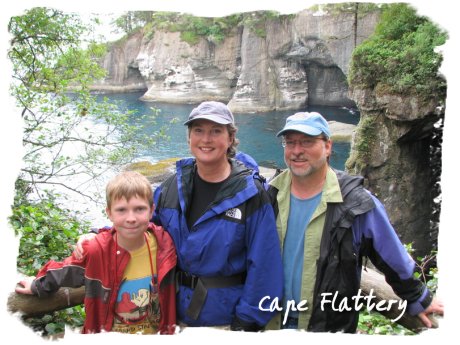
After our rainforest and hot springs adventures, we were ready for more coastline. Our travels will soon be turning eastward, away from the Pacific Ocean. It will be hard bidding farewell to the Pacific Coastline, particularly the wonderfully cool temperatures and dramatic scenery. With this in mind, we decided to spend the next couple of days exploring the coastal areas, including the far northwest corner of the Olympic Peninsula.
Cape Flattery
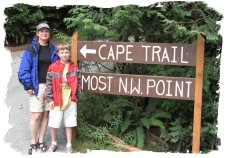 Located at the upper corner of the Olympic Peninsula, Cape Flattery is the most northwestern point in the contiguous 48 states. The brooding point is within the boundaries of the Makah Reservation, at the junction of the Pacific Ocean and the Strait of Juan de Fuca. Ships, whales, and Vance’s favorite bird, the Tufted Puffin, can all be viewed from the overlook at the end of the narrow cape.
Located at the upper corner of the Olympic Peninsula, Cape Flattery is the most northwestern point in the contiguous 48 states. The brooding point is within the boundaries of the Makah Reservation, at the junction of the Pacific Ocean and the Strait of Juan de Fuca. Ships, whales, and Vance’s favorite bird, the Tufted Puffin, can all be viewed from the overlook at the end of the narrow cape.I made a brief visit to the Cape during my time spent in Seattle in the mid 1980’s. I remember arriving just before dusk. The long drive down a dirt road, and then an equally long walk into the thick, fog covered woods, was spooky. There was no one around anywhere, and being on a remote reservation in the fading light rather freaked me out. However, the views at the end of the cape, with a lighthouse sitting on an offshore island, were spectacular. I’m happy to have the chance to return in brighter conditions.
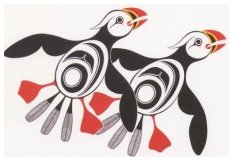 The road out to the cape is being paved, and the Makah tribe offers a free shuttle service. Once there, we walked the ½ mile trail to Cape Flattery, which had been greatly improved with a government grant several years ago. The views are every bit as good as I remembered, and Vance was quite excited to spot some Puffins floating in the ocean next to the cape. In contrast to my previous visit, there were quite a few people who had made the trek.
The road out to the cape is being paved, and the Makah tribe offers a free shuttle service. Once there, we walked the ½ mile trail to Cape Flattery, which had been greatly improved with a government grant several years ago. The views are every bit as good as I remembered, and Vance was quite excited to spot some Puffins floating in the ocean next to the cape. In contrast to my previous visit, there were quite a few people who had made the trek.On the way back, we spotted a traditional Salmon Bake underway – offered as a tribal fundraiser on the grounds of the Makah Cultural Museum. Using cedar sticks to hold the fish, the salmon was slowly baked over a driftwood fire. The father of the family offering the bake was a fisherman, and the salmon had been freshly caught just a few hours before. He would prep the salmon for baking in front of us – it was quite interesting to watch him trim the fat from the fish and spread the filets on the interleaved cedar sticks for baking.
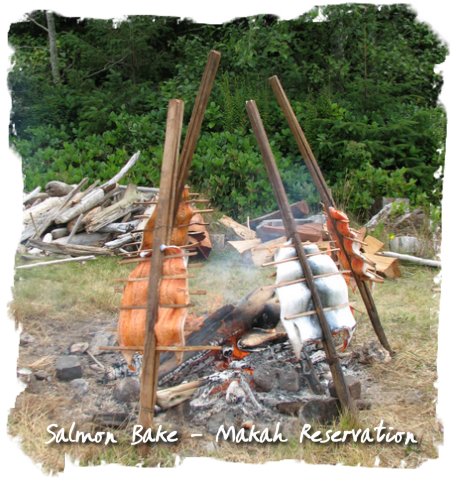
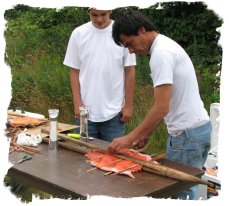 It was unbelievably good, and it probably has spoiled Denise and me forever. I don’t think a restaurant cooked salmon will satisfy either of us again. Before we got our plates, Vance was complaining loudly that he didn’t want salmon, he didn’t like salmon, he wanted something else to eat…..then he tried it.
It was unbelievably good, and it probably has spoiled Denise and me forever. I don’t think a restaurant cooked salmon will satisfy either of us again. Before we got our plates, Vance was complaining loudly that he didn’t want salmon, he didn’t like salmon, he wanted something else to eat…..then he tried it.He liked it so much he ate all of his, and then cajoled me into going back and purchasing another plate for me and him to split. If I hadn't run short of cash, he would have had me buy a third helping!
We finished up our afternoon touring the excellent and interesting Museum of the Makah Indian Nation. I usually glaze over at Indian museums – after awhile one piece of pottery looks about the same as another. But this one was very well done. The ancient Makah seaside village of Ozette had been buried under a mudslide for centuries, and thus preserved, until it was exposed by a storm in 1970. The museum was constructed to house the artifacts recovered from an archaeological dig at the village site. What made this so interesting was that the artifacts were displayed in context to various activities – tools for fishing, village life in the different seasons, trade goods, etc…This was much more interesting than the static displays you usually see full of arrowheads and broken pottery.
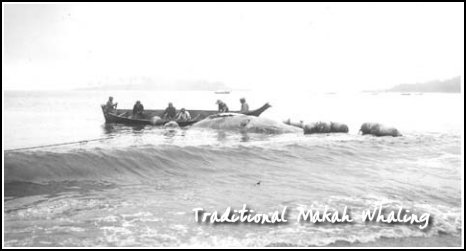
The Makah tribe largely relies economically on fishing. A series of court cases in the 1980’s established the rights of the northwestern Indian tribes to half of the annual salmon catch, and recent decisions have awarded the Makah the ability to resume whale hunting in a traditional manner. The tribes are allowed to fish in ways otherwise prohibited if they can prove that the method was traditionally used. The discovery of an ancient reed netting in the Ozette dig provided the Makah evidence in one court case that net fishing was a traditional fishing method.
Rialto Beach
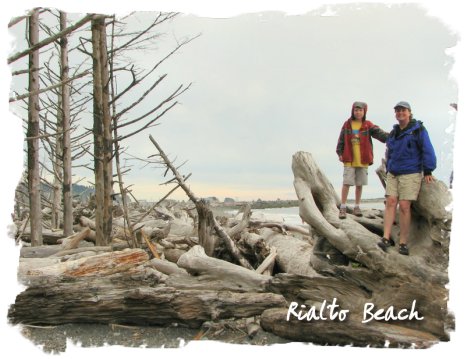
According to its description, Rialto Beach is covered in driftwood, and this proved to be accurate. Stacked along the high tide mark are a huge number of driftwood logs. There are numerous warnings posted describing the dangers of logs moving in the surf at high tide during storms, and it is easy to imagine being crushed under some of the monsters, many of which were obviously huge Douglas Firs when they were alive. The tangled piles of driftwood along the beach are a pretty sight, the giant logs providing shelter from the wind for many campers who have set up small tents in amongst them.
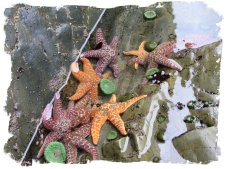 We had heard there were tidal pools located at ‘Hole in the Wall’, a large rock formation about a mile down the beach. It was nearly low tide, so we set out to visit them, hoping to see more sea stars and other marine life. We weren’t disappointed. Hopping around the slick rocks and dodging the spray from incoming waves, we found numerous pockets of brightly colored sea stars.
We had heard there were tidal pools located at ‘Hole in the Wall’, a large rock formation about a mile down the beach. It was nearly low tide, so we set out to visit them, hoping to see more sea stars and other marine life. We weren’t disappointed. Hopping around the slick rocks and dodging the spray from incoming waves, we found numerous pockets of brightly colored sea stars.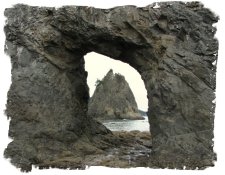 ‘Hole in the Wall’ is just that, a sizable tunnel thru a small cape jutting out into the water. The tide was still low enough where we could walk through to more tidepools on the other side. On our return, Vance and I took a short trail that looped over the top of the little cape, giving us a dramatic view of the whole beach.
‘Hole in the Wall’ is just that, a sizable tunnel thru a small cape jutting out into the water. The tide was still low enough where we could walk through to more tidepools on the other side. On our return, Vance and I took a short trail that looped over the top of the little cape, giving us a dramatic view of the whole beach.On the walk back, we passed a group of guys playing baseball using driftwood for bats and the round stones the beach was littered with for balls. It seemed to work pretty well, although we had to take extra care not to get beaned by a stray hit! It was a nice walk on a wild coast – I’d love to come back and camp on the beach in the driftwood some time.
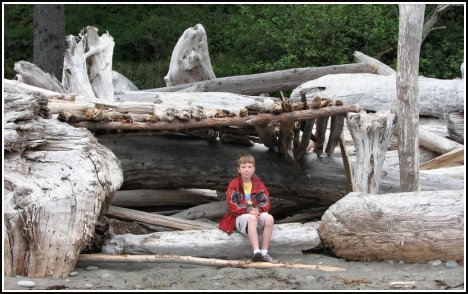
Rialto Beach is located just across the mouth of the Quileute River from the Quileute Tribal village of La Push. The Quileute have a unique language, one of only five in the world without any nasal sounds. Unlike the Makah villages, which were well kept, La Push was simply depressing. Despite a beautiful setting on the coast, the village looked like something out of a third world country. The economic situation of many tribes remains desperate, particularly small tribes like the Quileute, whose reservation at La Push is a mere one square mile. It’s hard to fault Indian tribes for all of the casinos popping up all over the west, when you see the alternative.
Although several beaches on the La Push reservation were crowded with visitors, the Quileute have for some reason been unable to capitalize on the tourism. Needless to say, we didn’t hang around long in La Push – a very different visit than our one with their Makah neighbors to the north.
With this we bid adieu to the Forks area... tomorrow we move to the northern edge of the Peninsula near Port Angeles. From there we will visit more of Olympic National Park, and take a hop across the Strait of Juan de Fuca to Victoria, Canada!

Vance: The western Olympic Peninsula is in Washington State. A peninsula is land surrounded by water on three sides. It is mainly known for scenic beauty. It’s also known for the wildlife.
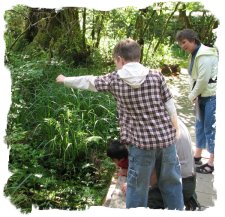 Our first stop was the Hoh Rainforest. We went to a visitor center and took a ranger led walk in the Hall Of Mosses. One unique feature is the nurse log. This kind of tree falls and other trees grow on it because it supplies nutrients. A ranger also let us feed the baby Coho salmon some bugs.
Our first stop was the Hoh Rainforest. We went to a visitor center and took a ranger led walk in the Hall Of Mosses. One unique feature is the nurse log. This kind of tree falls and other trees grow on it because it supplies nutrients. A ranger also let us feed the baby Coho salmon some bugs.Next we have the Sol Duc Hot Springs. Interestingly enough, it even has a swimming pool. I usually went to swim in the pool, then got back in the hot tub. After you get out you are supposed to drink lots of water because the hot water dehydrates you.
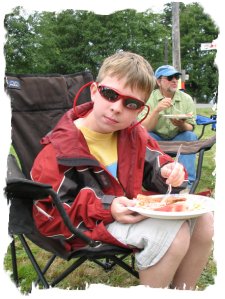 We got lucky to go up and see Cape Flattery before the storm. It is the most Northwest Point in the country except for Alaska and Hawaii. We even saw some Tufted Puffins in the water. Anybody remember the Newport Aquarium blog? Then we went to a salmon bake near the Makah Indian museum. The light was dim in the museum to protect the artifacts.
We got lucky to go up and see Cape Flattery before the storm. It is the most Northwest Point in the country except for Alaska and Hawaii. We even saw some Tufted Puffins in the water. Anybody remember the Newport Aquarium blog? Then we went to a salmon bake near the Makah Indian museum. The light was dim in the museum to protect the artifacts.The Olympic Peninsula is beautiful. I enjoyed Cape Flattery most of all. I thought I wasn't going to like the salmon, but it was really good. The Makah museum reminded me a lot of my Cherokee ancestors.
(Note: Vance is 1/64th Cherokee on his mother's side)
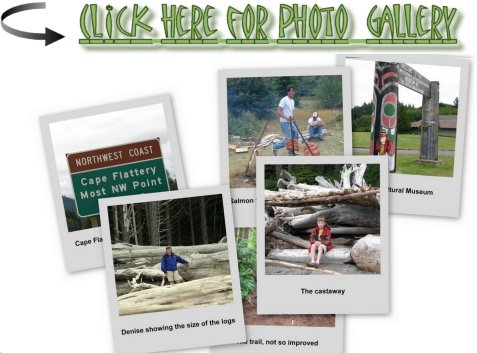
| Previous - Drip, Drip, Drip | | Home | Index | | Bright ideas in the fog! - Next |







<< Home